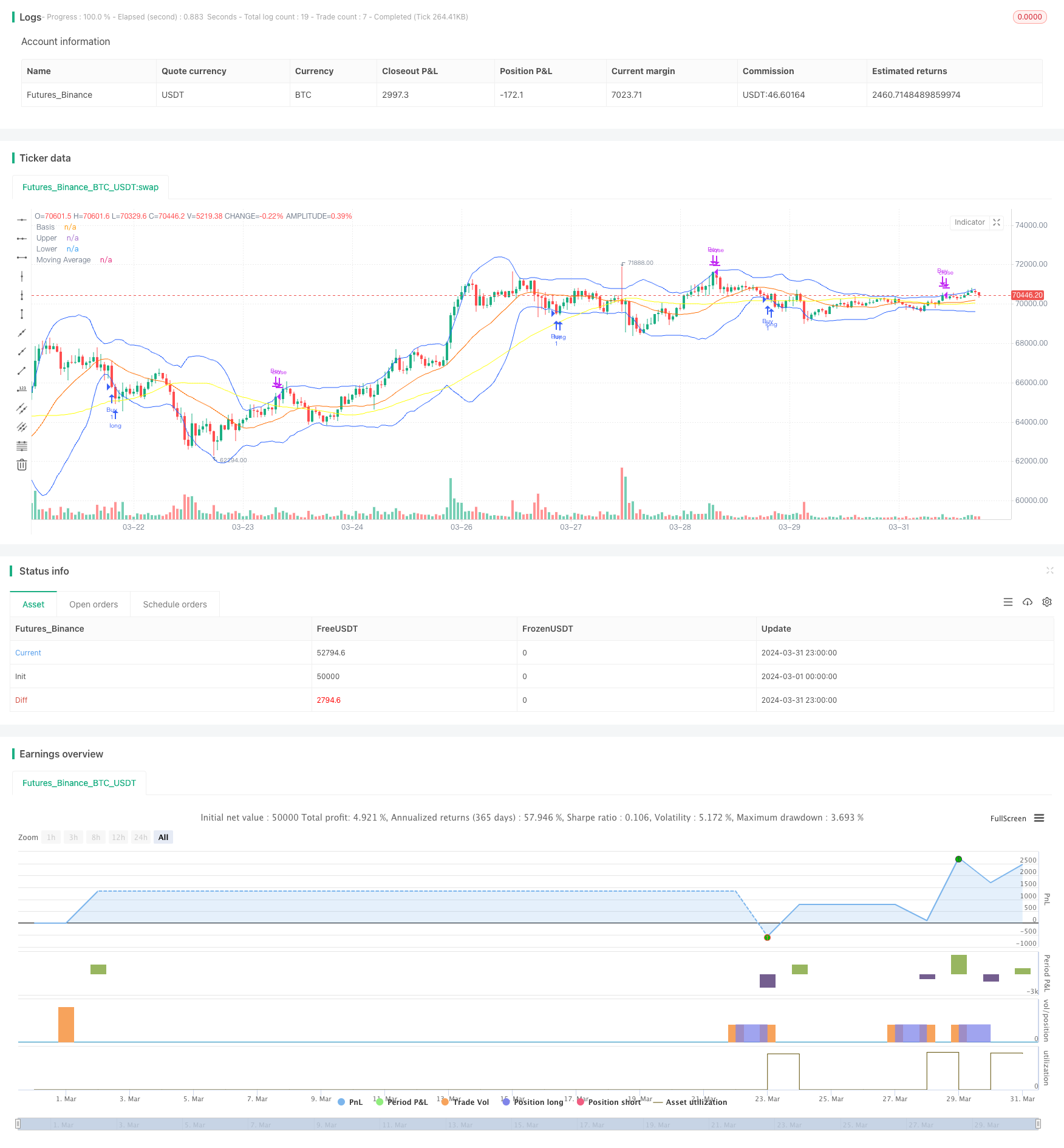
概述
Modified Bollinger Bands Strategy是一个技术分析交易策略,旨在捕捉强势上涨趋势中的回调买入机会。该策略结合了布林带、移动平均线和随机RSI指标,以确定最佳的买入时机。当价格在上升趋势中回调至布林带下轨且随机RSI指标显示超卖时,策略将发出买入信号。当价格突破布林带上轨时,策略将平仓。
策略原理
- 布林带:布林带由三条线组成,中轨为移动平均线,上下轨为中轨加减一定标准差。布林带可以反映价格的波动情况,当价格波动加剧时,布林带变宽;当价格波动减弱时,布林带变窄。
- 移动平均线:策略采用50周期简单移动平均线作为趋势过滤器。只有当收盘价在移动平均线之上时,才考虑做多,这表明当前处于上升趋势。
- 随机RSI:随机RSI是一个动量振荡指标,用于衡量特定时间段内RSI相对于其高低范围的水平。它可以产生超买和超卖信号。在该策略中,随机RSI为进场交易提供了一个额外的条件,旨在识别价格在持续上涨趋势中回调至超卖区域的时刻,提供潜在的买入机会。
策略的买入条件如下: - 收盘价跌破布林带下轨,表明价格可能出现超跌。 - 收盘价仍高于50周期简单移动平均线,表明总体趋势仍然看涨。 - 随机RSI显示超卖条件(K线低于用户定义的阈值,通常为20),表明最近的下跌趋势可能出现反转或回调。
策略的卖出(平多头仓位)条件如下: - 收盘价突破布林带上轨,意味着价格可能已达到短期顶部,可能出现反转或回调。
策略优势
- 趋势跟踪:通过使用移动平均线作为趋势过滤器,该策略可以帮助交易者在强势的上涨趋势中寻找入场机会。这有助于避免在下跌趋势中交易,从而提高策略的胜率。
- 波动性管理:布林带可以帮助交易者了解价格的波动性。通过在布林带下轨买入,该策略试图在价格回调至相对较低的水平时进场,从而在趋势恢复时获利。
- 动量确认:随机RSI指标有助于确认潜在的买入机会。通过要求随机RSI显示超卖条件,该策略试图避免在下跌趋势仍在主导时过早进场。
策略风险
- 缺乏风险管理:该策略没有内置止损或仓位规模管理功能。在实际交易中,这些都是至关重要的风险管理工具。交易者需要根据自己的风险承受能力和交易目标,确定适当的止损位和仓位大小。
- 参数敏感性:策略的表现可能对布林带长度、移动平均线长度和随机RSI参数的选择很敏感。不同的参数组合可能产生不同的结果。在实施该策略之前,有必要对这些参数进行优化和回测。
- 趋势逆转:尽管该策略试图在上升趋势中买入回调,但并不能保证趋势将持续。如果趋势突然逆转,该策略可能会遭受损失。
策略优化方向
- 增加风险管理:在策略中加入止损和仓位规模管理功能,以帮助限制潜在损失并优化风险回报。可以考虑基于ATR(平均真实范围)或百分比回撤的动态止损。
- 优化参数:对布林带长度、移动平均线长度、布林带标准差倍数和随机RSI参数进行优化,以提高策略在不同市场条件下的表现。可以使用遗传算法或网格搜索等优化技术来找到最佳参数组合。
- 结合其他指标:考虑将其他技术指标纳入策略,如MACD或OBV,以提供额外的确认信号并帮助过滤假信号。
- 回测和前瞻性测试:在不同的市场条件和时间框架下,对策略进行彻底的回测。使用前瞻性测试来评估策略在样本外数据上的表现,以验证其稳健性。
总结
Modified Bollinger Bands Strategy是一个简单而有效的交易策略,旨在捕捉强势上涨趋势中的回调买入机会。通过结合布林带、移动平均线和随机RSI指标,该策略试图识别价格超跌但总体趋势仍然看涨的情况。尽管该策略有一些优点,如趋势跟踪和波动性管理,但它也存在一些风险,如缺乏风险管理和参数敏感性。通过纳入适当的风险管理技术、优化参数和结合其他指标,可以进一步改进该策略。在实际应用之前,有必要对策略进行全面的回测和前瞻性测试。
策略源码
/*backtest
start: 2024-03-01 00:00:00
end: 2024-03-31 23:59:59
period: 1h
basePeriod: 15m
exchanges: [{"eid":"Futures_Binance","currency":"BTC_USDT"}]
*/
//@version=5
strategy("Modified Bollinger Bands Strategy", shorttitle="Mod BB Strategy", overlay=true)
// Input parameters for Bollinger Bands
length = input.int(20, minval=1, title="BB Length")
mult = input.float(2.0, minval=0.001, maxval=50, title="BB StdDev")
// Input parameters for moving average
maLength = input.int(50, minval=1, title="MA Length")
// Input parameters for Stochastic RSI
kLength = input.int(14, title="Stoch RSI K Length")
dLength = input.int(3, title="Stoch RSI D Length")
rsiLength = input.int(14, title="Stoch RSI Length")
oversold = input.float(20, title="Stoch RSI Oversold Level")
// Calculate Bollinger Bands
basis = ta.sma(close, length)
dev = mult * ta.stdev(close, length)
upperBB = basis + dev
lowerBB = basis - dev
// Calculate Moving Average
movingAvg = ta.sma(close, maLength)
// Calculate Stochastic RSI
rsi = ta.rsi(close, rsiLength)
k = ta.sma(ta.stoch(rsi, rsi, rsi, kLength), dLength)
d = ta.sma(k, dLength)
// Define buy and sell conditions
longCondition = close < lowerBB and close > movingAvg and k < oversold
exitCondition = close > upperBB
// Plotting
plot(basis, "Basis", color=color.new(#FF6D00, 0))
plot(upperBB, "Upper", color=color.new(#2962FF, 0))
plot(lowerBB, "Lower", color=color.new(#2962FF, 0))
plot(movingAvg, "Moving Average", color=color.new(#FFFF00, 0))
// Execute strategy
if (longCondition)
strategy.entry("Buy", strategy.long)
if (exitCondition)
strategy.close("Buy")